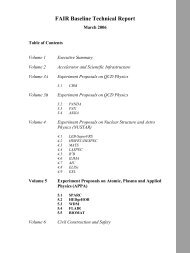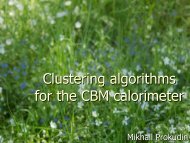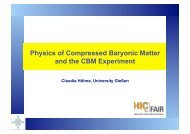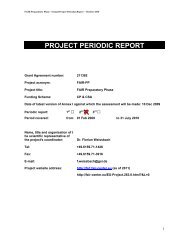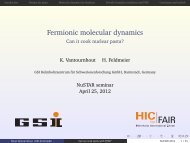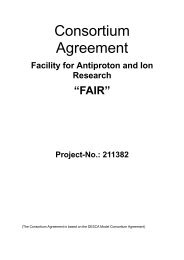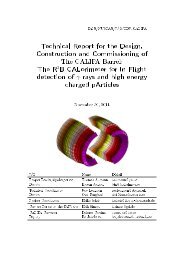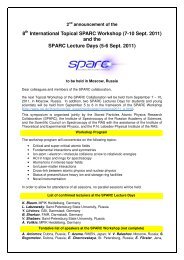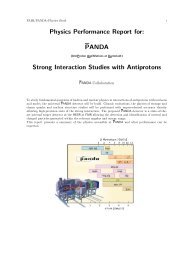NeuLAND - FAIR
NeuLAND - FAIR
NeuLAND - FAIR
You also want an ePaper? Increase the reach of your titles
YUMPU automatically turns print PDFs into web optimized ePapers that Google loves.
processes in the universe, such as the properties of neutron stars and the synthesis of the<br />
heavy elements. R 3 B will constitute a unique setup to investigate these topics utilizing<br />
relativistic beams. The advantages of utilizing high-energy beams are many-fold. First,<br />
the production, separation, and identification of radioactive beams at high energies is<br />
very efficient due to the kinematical forward focussing and the possibility to use thick<br />
targets. Second, it also enables a clean separation of even heavy beams with masses<br />
A ≥ 200 due to the fact that ions are fully stripped, a pre-requisite for the magnetic<br />
analysis and separation of heavy ions. Similar arguments hold for the measurement<br />
of secondary reactions with these beams. R 3 B will be the first experiment which will<br />
allow a kinematically complete measurement of peripheral reactions with such heavy ion<br />
beams including the coincident detection and identification of the heavy residues as well<br />
as neutrons and photons. Other advantages of the high beam energy are related to the<br />
reaction mechanisms, which become simpler, permitting reliable model description, at<br />
higher beam energies. At high velocity, reactions can be accurately described by theory,<br />
nuclear-structure observables are less entangled with the reaction mechanism, and can<br />
thus be deduced more precisely.<br />
In this report we do not describe the complete R 3 B experimental setup with its instrumentation<br />
but we would like to refer the reader to the R 3 B Technical Proposal [R3B-05].<br />
However, to understand the context, we briefly mention the development and construction<br />
status of the main components of the R 3 B setup, as shown in figure 1.1.<br />
Key instruments besides <strong>NeuLAND</strong>, are the photon and particle calorimeter CALIFA,<br />
the silicon tracker R 3 B-Si-TRACKER, and the super-conducting large-acceptance dipole<br />
R 3 B-GLAD. In addition, several charged-particle detectors are used for beam tracking,<br />
∆E and time-of-flight measurements. The CALIFA detector consists of two parts, the<br />
forward end-cap and the barrel part. A Technical Design Report for the barrel part of<br />
CALIFA is being submitted in parallel to this report. Construction is foreseen to start<br />
in 2012. The Technical Design of the end-cap is still ongoing and will be finalized in<br />
2013. The target recoil detector is being designed by a consortium of institutes from the<br />
UK under the leadership of Daresbury laboratory. The funds for the R&D and the final<br />
construction are secured by the UK funding agencies and the complete detector will be<br />
available for experiments in 2016. The construction of the superconducting dipole magnet<br />
has already started at CEA Saclay and the cold mass including the superconducting<br />
coils have been already assembled. The completion and delivery of the device is foreseen<br />
for the end of 2012. The magnet will then be installed in Cave C at the present GSI<br />
facility.<br />
The challenges of performing nuclear-structure and reaction experiments at relativistic<br />
beam velocities are related to the high magnetic rigidity of the ions and the demands<br />
on the overall resolution of the detection system. The experiment has to resolve excitation<br />
energies in the 100 keV domain populated in a reaction with, e.g., a 132 Sn beam<br />
(1 AGeV) with a momentum of 220 GeV/c. The precursor experiment of R 3 B, the<br />
ALADIN-LAND setup at GSI, on which the concept of R 3 B is based, does not have these<br />
capabilities. Although very successful during the past 20 years, the main limitations of<br />
14





